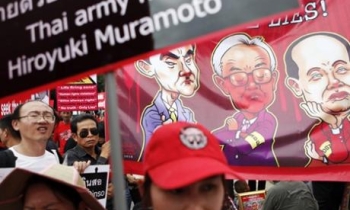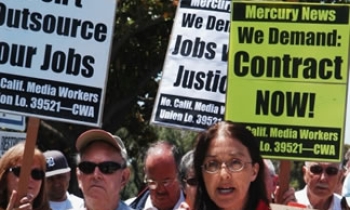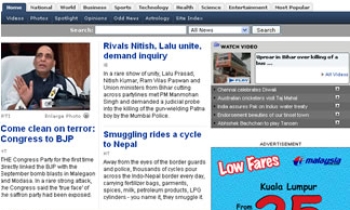Embattled Hewlett-Packard Chairman Patricia Dunn resigned Tuesday in the face of trenchant criticism for ordering a controversial board investigation into boardroom leaks to the press. HP's probe into boardroom leaks dating back to 2005 sparked a media furore, as well as an inquiry by California's attorney-general that could result in criminal liability for identity theft and illegally accessing database information.

Dunn, 52, had defended her role in the inquiry, insisting that she did not know private investigators hired by the computer manufacturer had used "questionable" tactics to access private phone records of board directors and journalists.
"Unfortunately, the investigation, which was conducted with third parties, included certain inappropriate techniques," said Dunn in a statement on Tuesday. "These went beyond what we understood them to be, and I apologise that they were employed."
HP disclosed last week that the California attorney general's office had begun an investigation into the procedures used in the probe, in which investigators used subterfuge to obtain phone records of board members and nine reporters. Nine journalists from the New York Times, Wall Street Journal, BusinessWeek, and online news site CNET.com were told their phone records might have been accessed.
Thomas Perkins, the prominent and wealthy Silicon Valley venture capitalist who quit the HP board in May to protest the investigation, on Saturday called on Dunn to resign as chairman of the computer maker. Dunn had said last week that she had no plans to resign unless asked by the board. The board held an informal telephone conference on Sunday to discuss the probe and met again on Monday evening.
The pressure on Dunn to step down mounted on Monday when Congress and federal investigators entered the fray surrounding HP's possibly illegal probe of media leaks. The FBI, the US Attorney for Northern California and the House Energy and Commerce Committee all joined the probe of the scandal swirling around HP's Board of Directors, according to BusinessWeek, three of whose journalists were probed by HP.
HP spokesman Ryan Donovan said Dunn "stepped down voluntarily to minimise the distraction to the company." Chief Executive and President Mark Hurd will succeed Dunn as chairman, as well as retain his existing positions, HP said in a statement. Dunn will continue to serve on the board as a director.
Acording to BusinessWeek, HP began its investigation in late spring 2005 after a series of leaks about board and management meetings, including details about then-Chief Executive Carleton Fiorina's leadership. In January, 2006, CNET published a story containing information that HP believed only a board member would have known. This was followed by stories in a number of publications that cited inside sources, prompting Dunn to intensify the probe into who on the board was the source of the leaks.

The detectives hired another consultancy that engaged in a practice known as pretexting, which involves pretending to be a customer of a phone company to obtain calling records. Pretexting is only considered a crime under federal law when it's used to obtain information from financial institutions. California, however, is considering charging those involved with the pretexting operation as violating three state statutes. Two of the statutes deal with unauthorised access to computer data and wrongfully copying the data, while a third covers the unauthorised access to personal identifiers such as Social Security numbers, according to the Register.
In May, the New York Times reported, the investigation identified the board’s longest-serving member, George A Keyworth II, as the source of the leak. He rebuffed a request to resign, but the company said he would not be renominated. Thomas J Perkins, another board member and a powerful Silicon Valley venture capitalist, resigned in anger over the way the investigation was conducted. His efforts to get the company to acknowledge the reason for his departure led to the recent disclosures. Keyworth was the science advisor to US President Ronald Reagan and director of the White House’s Office of Science and Technology Policy from 1981 to 1986. He too resigned Tuesday.
The matter burst into the public eye on September 5, a BusinessWeek story said, when news outlets reported that Perkins had asked the Securities & Exchange Commission to require HP to file an explanation for his resignation last May. Perkins said he resigned to protest the "questionable ethics and dubious legality" of the probe, which Dunn said she launched in late spring of 2005.
Events leading up to the boardroom scandal at Hewlett-Packard Co. over the company's investigation of media leaks (Associated Press):
- Feb 9, 2005: Board member Patricia Dunn announces that Chief Executive Carleton Fiorina has been fired. Dunn assumes role as nonexecutive chairwoman and oversees the hunt for Fiorina's successor.
- Mar 29, 2005: Dunn announces that Mark Hurd has been hired as the new CEO. Dunn retains the chairwoman title.
- Jan 23, 2006: CNET Network Inc.'s News.com publishes a story quoting an anonymous HP source who described a confidential gathering of HP directors. Although the source didn't say anything inflammatory, the leak reportedly angered Dunn.
- Jan 29-Feb 2, 2006: Someone creates an online account in the name of HP board member and noted Silicon Valley venture capitalist Thomas Perkins and orders his home phone records from AT&T Inc.
- May 18, 2006: During a board meeting, Dunn identifies the leaker as George Keyworth II, the longest-serving HP director. The board asks Keyworth to resign, but he refuses. Perkins gets angry, resigns and storms out of the meeting.
- May 22, 2006: HP files a routine document with the Securities and Exchange Commission to notify investors that Perkins has resigned.
- June and July 2006: Perkins and his attorney demand information from HP about the methods used to identify Keyworth as a leaker. Perkins begins asking HP to submit details of his resignation _ and the probe into his home phone numbers _ to the SEC.
- Aug 16, 2006: Investigators for California's attorney general and the California Highway Patrol Computer Crimes Investigation Unit meet with AT&T executives. AT&T confirms that it's conducting an internal review of pretexting, the practice of impersonating a person in order to access their private information.
- Aug 31, 2006: The State of California issues a search warrant for Cox Communications Inc., which owns the Internet address where Perkins' phone records were sent.
- Sep 6, 2006: HP reports to the SEC that it used pretexting to get phone records of "HP directors and individuals outside of HP."
- Sep 7, 2006: California Attorney General Bill Lockyer announces that the pretexting broke two state laws governing identity theft and illegal access to computer records, and that his office was investigating whether criminal charges were warranted.
- Sep 8, 2006: Dunn calls journalists who were targeted by pretexters to apologize, but defends the right of the company to determine the source of the leaks.
- Sep 9, 2006: Perkins calls on Dunn to resign.
- Sep 11, 2006: A House committee requests documents related to the leak investigation as part of its ongoing probe of pretexting, while the U.S. Attorney's office in San Francisco and the FBI confirm they are conducting their own probe of HP's conduct.
- Sep 12, 2006: HP announces that Dunn will step down as chairwoman in January 2007 and be replaced by Hurd. Dunn will remain a director, while Richard Hackborn will become lead independent director in January.









